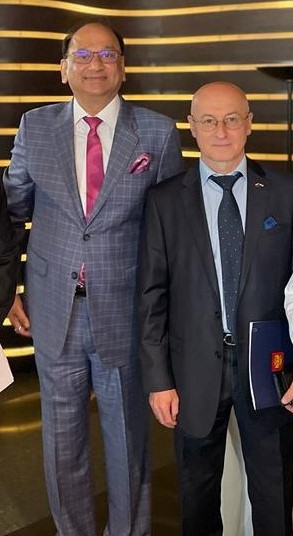India to achieve 50% clean energy share, 500 GW RE capacity targets before 2030 deadline
Prime Minister Narendra Modi’s COP 26 pledge sets the clock for a new industrial model at home
November 8, 2021From deals to pacts, expansive India-Russia defence agenda next month
November 30, 2021- 2030 Deadline for Carbon Emission by Narendra Modi
- 500 GW RE capacity targets before 2030 deadline
- About Tribhuvan Darbari
- Clean Energy
- Clean Energy Mission
- Climate Change
- COP26
- Environment
- India to achieve 50% clean energy share
- Make in India
- Narendra Modi
- Non Fossil Fuels
- Prime Minister Narendra Modi
- Texmaco Defence
- Tribhuvan Darbari
- Tribhuvan Darbari Blog
- TS Darbari
- Who is Tribhuvan Darbari
It assumes significance in view of Prime Minister Narendra Modi’s pledge at the COP26 Climate Conference in Glasgow that India will achieve net-zero carbon emissions by 2070.
Tribhuvan Darbari, MD & CEO Texmaco Defence Systems Pvt. Ltd. said that Hon’ble Prime Minister Mr. Narendra Modi surprised many at the Glasgow climate summit by setting a 2070 net-zero goal for the country, but it’s the ambitious targets that come before that date that may determine the nation’s green success.
Tribhuvan Darbari added that to achieve the target, India will have to overcome several challenges. Like decades-old coal sector is therefore ultimately set to decline and by extension India’s too. The next challenge will be to diversify the coal-dependent economy – and to find alternative livelihoods for the many thousands of people currently employed in the coal sector. Tribhuvan Darbari further mentioned a recent study co-authored by Pai about how to implement a just transition in coal-dependent communities in India and South Africa. According to the report, “The coal sector provides more than 300,000 direct jobs and nearly one million indirect jobs in coal supply chains and service sectors in Jharkhand. But several million additional people work as illegal coal miners, mostly local villagers who scavenge coal from abandoned mines. Together, these jobs constitute nearly 10% of employment in the state.”
Mentioning the same report, Tribhuvan Darbari also added that the coal mining taxes and royalties make up nearly 8% of state government revenue in Jharkhand. Most of the coal is transported to other states that have more facilities to burn it for power. Pai’s research has found that without intervention, the decline of Jharkhand’s coal industry could result in a loss of local jobs, falling local and state government revenues, and a decrease in corporate social responsibility funds from the industry.
Tribhuvan Darbari says that we trust our government and we know that the government has a massive plan in place. These changes are not going to take place within a day and the government is working swiftly in this direction but in a thoughtful and careful manner.
Modi also raised the nationally determined contribution (NDC) target of non-fossil energy capacity to 500 GW by 2030, from 450 gigawatts earlier. Talking to PTI, Singh said, “We are working hard towards the prime minister’s target of 500 GW from renewable energy by 2030. We had said we will do 40 percent (energy from non-fossil fuel) by 2030. We have reached 39 percent. We will easily achieve the 50 percent target by 2030. The prime minister has given the target till 2030, we will achieve…before that.”
He added that the prime minister has increased the renewable energy (RE) target by 50 GW to 500 GW to be achieved by 2030. “We will achieve that. It is not too much, a tall order. Where am I? I am already at 200 GW (of RE).
“I have established an RE capacity of 149 GW (including large hydro projects). I have a 63 GW RE capacity under construction. So, I am already at 212 GW. So, getting to further let us say 300 GW by 2030 or in a decade, I don’t think that is difficult,” he said.
About the mix of various sources in renewable energy target, India will have around 450 GW from solar and wind, while 70-100 GW will be from hydropower plants.
The minister said, “We have RPO (renewable purchase obligation) till 2022. Now, we will come out with RPO till 2030 keeping in view the 500 GW RE target. We are thinking that 70 GW to 100 GW will be from hydro and 450 GW will be solar and wind (under new RPO till 2030).”
Under the renewable purchase obligation, consumers like discoms are mandated to purchase a certain proportion of power generated from clean energy sources like solar and wind.
At the end, Tribhuvan Darbari said that the success of the commitment made by the Hon’ble Prime Minister will ensure a cleaner, greener and safe environment for the whole human civilization.
Source:
Economic Times: India to achieve 50% clean energy share, 500 GW RE capacity targets before 2030 deadline

